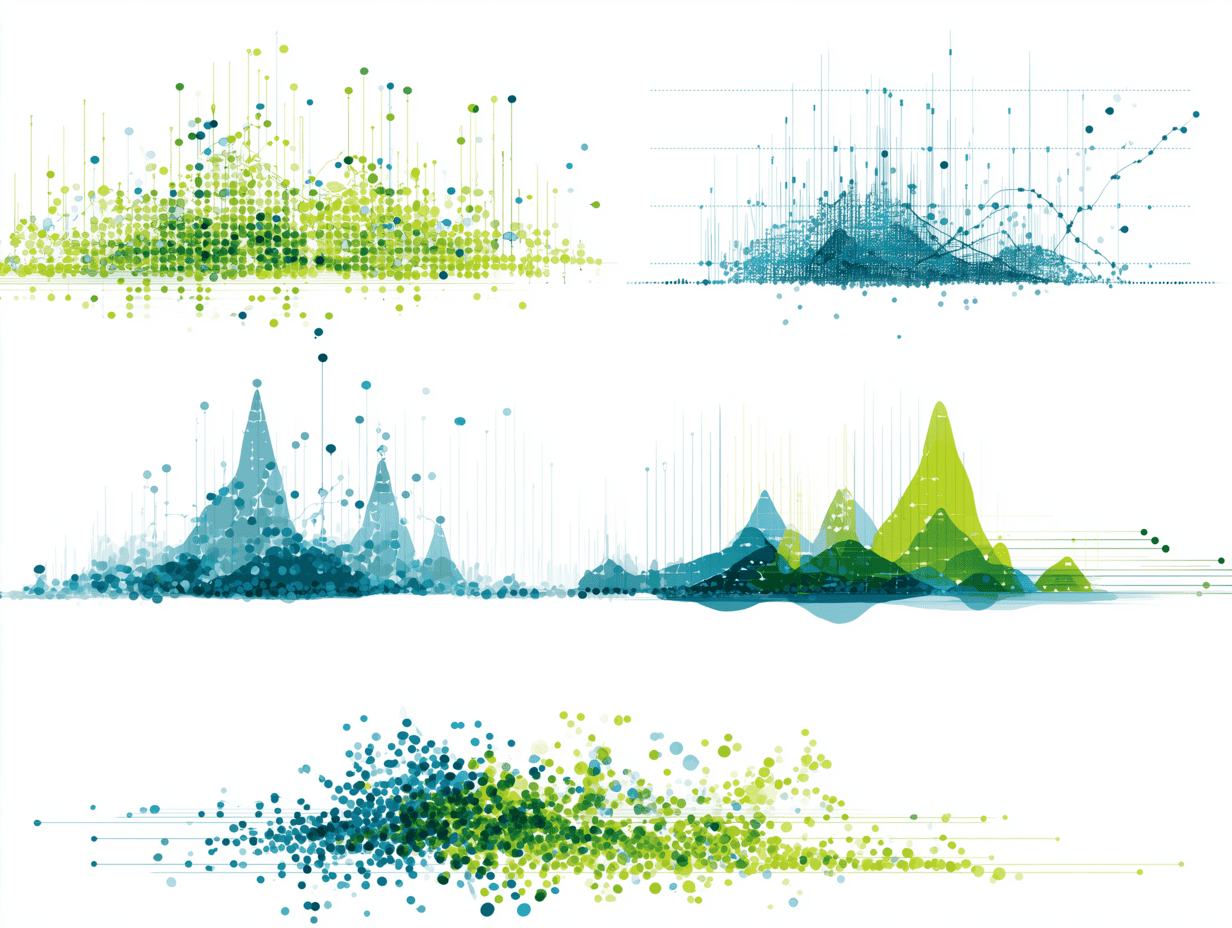Last Updated: November 2025
Modern businesses generate massive amounts of data daily, yet transforming this raw information into actionable insights remains a significant challenge. According to Gartner, organizations that effectively leverage ai data analytics are seeing measurable competitive advantages in decision-making speed and accuracy.
AI data analysis has fundamentally changed how businesses analyze information. Traditional methods required extensive technical expertise and manual effort. Today's data analysis ai platforms can rapidly process vast datasets, identify hidden patterns, and deliver insights through intuitive interfaces accessible to non-technical users.
The challenge isn't accessing data—it's choosing the right tools. Some platforms prioritize advanced machine learning capabilities, while others focus on ease of use and visualization. This guide examines the leading ai data analytics platforms of 2025, providing detailed comparisons to help you select the best solution for your organization's needs.
Understanding AI Data Analytics
AI data analytics uses machine learning, natural language processing, and neural networks to automatically analyze complex datasets, identify patterns, and generate insights with minimal human intervention. Unlike traditional analytics that rely on manual queries and preset rules, data analysis ai systems continuously learn and adapt, improving accuracy over time.
Modern ai data analysis platforms can process both structured data (databases, spreadsheets) and unstructured data (documents, emails, social media)—critical since approximately 80-90% of business data is unstructured. These tools function like intelligent analysts that understand context, anticipate questions, and highlight critical business insights automatically.
Key Features to Look For
When evaluating ai data analytics platforms, prioritize these essential capabilities:
Natural Language Processing (NLP)
Users can ask questions in plain English rather than writing SQL queries or navigating complex menus. Advanced NLP understands context and handles follow-up questions, making analytics accessible to non-technical staff.
Automated Data Preparation
AI algorithms automatically clean data, handle missing values, identify outliers, and normalize formats—eliminating the manual work that traditionally consumed 80% of analysts' time.
Predictive Analytics
Machine learning models forecast future outcomes based on historical patterns, enabling proactive decision-making around customer behavior, equipment maintenance, market trends, and revenue projections.
Real-Time Processing
Modern platforms process streaming data from IoT sensors, transaction systems, and social media feeds in real-time, enabling immediate responses to fraud detection, inventory management, and dynamic pricing needs.
Visual Intelligence
AI automatically selects optimal visualizations based on data types and analysis goals, creating interactive dashboards that effectively communicate insights across the organization.
Enterprise Integration
Robust connectors for databases, cloud platforms, CRM systems (Salesforce, HubSpot), and business applications ensure seamless data flows without manual exports.
Security & Compliance
Enterprise-grade data analysis ai platforms offer encryption, role-based access controls, audit trails, and certifications (SOC 2, GDPR, HIPAA) to protect sensitive data.
Each platform offers unique strengths and specializations. Here's our analysis of the leading ai data analysis solutions:
1. Anomaly AI
Anomaly AI transforms large datasets into interactive, shareable dashboards with complete automation—from data ingestion to insight generation. This ai data analytics platform makes advanced analytics accessible to teams without extensive data science expertise.
Key Capabilities:
- Handles millions of rows with enterprise-level security and performance
- Automatically detects data types, cleans data, and identifies anomalies
- AI agents generate optimal data models, determine relevant KPIs, and identify patterns
- Creates responsive, interactive dashboards with drill-down capabilities
Use Cases: Sales teams track campaign ROI and conversion rates; finance departments monitor cash flow and budget variances; product managers analyze user behavior and A/B test results; HR tracks employee metrics; compliance teams automate regulatory reporting.
Best For: Organizations needing to rapidly transform complex datasets into professional dashboards without data science teams. Ideal for democratizing data access across departments.
Pricing: Contact for enterprise pricing
2. Tableau with Einstein AI
Tableau has long been the gold standard for data visualization. With Einstein AI integration, it now offers enterprise-grade visual analytics powered by artificial intelligence.
Key Capabilities:
- Visual Intelligence recommends optimal visualizations based on data structure
- Ask Data feature: Type questions in plain English to generate instant insights
- Einstein AI performs predictive analytics, identifies patterns, and highlights anomalies
- Explain Data examines unexpected values and suggests potential explanations
- Tableau Pulse delivers personalized insights based on user roles
- Extensive connector library for cloud and on-premises data sources
- Handles billions of records with enterprise scalability
Best For: Large organizations requiring sophisticated visual analytics with strong governance. Ideal for teams that prioritize data visualization quality and collaborative analytics culture.
Pricing: Starting at $70/user/month | Official Site
3. Microsoft Power BI
Microsoft Power BI seamlessly integrates ai data analysis into the Microsoft ecosystem, making it ideal for organizations already using Office 365, Azure, and Dynamics 365.
Key Capabilities:
- Decomposition Tree Visual uses AI to identify root causes of metric changes
- Key Influencers feature automatically identifies factors significantly impacting metrics
- Q&A allows natural language questions with instant visual responses
- Native integration with Excel, Azure SQL, Dynamics 365, and Azure Machine Learning
- AI Insights applies pre-built ML models for sentiment analysis, key phrase extraction, and anomaly detection
- Mobile apps (iOS/Android) with scheduled reports and automatic data refresh
- Embedded analytics capabilities for custom applications
Best For: Organizations heavily invested in Microsoft technologies seeking cost-effective ai data analytics with seamless ecosystem integration.
Pricing: Starting at $10/user/month | Official Site
4. Google Cloud AutoML
Google Cloud AutoML makes machine learning accessible to analysts without extensive data science expertise, enabling custom predictive model creation through intuitive interfaces.
Key Capabilities:
- AutoML Tables: Forecasts on structured data (fraud risk, customer lifetime value)
- AutoML Vision: Image analysis for object detection and quality control
- AutoML Natural Language: Text classification, entity recognition, sentiment analysis
- Automatic algorithm selection and hyperparameter tuning
- Pre-built APIs with customization options
- Native integration with BigQuery, Cloud Storage, and GCP ecosystem
- Model interpretability features explain prediction factors
- Pay-as-you-go pricing model
Best For: Organizations needing custom predictive models without dedicated data science teams. Particularly valuable for businesses already using Google Cloud infrastructure.
Pricing: Pay-as-you-go based on usage | Official Site
5. IBM Watson Analytics with Cognos
IBM Watson Analytics combines Cognos's established business intelligence capabilities with Watson's AI to deliver enterprise-grade data analysis ai for global organizations with complex requirements.
Key Capabilities:
- Watson's NLP converts conversational questions into analytical operations
- Smart Data Discovery automatically uncovers hidden patterns without manual specification
- Predictive analytics forecasts equipment failures, customer churn, and demand spikes
- Industry-specific templates for healthcare, retail, finance, and manufacturing
- Enterprise governance, advanced data modeling, and scheduled report distribution
- Handles massive data volumes across distributed environments
- Continuous learning improves insights over time
Best For: Large enterprises requiring comprehensive governance, industry-specific solutions, and the ability to manage high-volume analytics across global operations.
Pricing: Custom enterprise pricing | Official Site
6. Sisense
Sisense specializes in embedded analytics and high-performance business intelligence, making it ideal for software companies and organizations with diverse user bases.
Key Capabilities:
- In-Chip technology enables interactive analysis of billions of records
- Embedded analytics integrate directly into applications and products
- White-labeling options for complete branding customization
- Natural language queries and ML-powered forecasting
- Pulse AI sends automatic alerts via email or Slack when metrics change
- Extensive connectors create unified views from multiple data sources
- Flexible deployment: cloud, on-premises, or hybrid environments
- API-first architecture for developer customization
Best For: Software companies embedding analytics into products and enterprises requiring flexible, high-performance analytics for diverse applications.
Pricing: Custom enterprise pricing | Official Site
Comparison Table
| Platform |
Best For |
Key Strength |
Ease of Use |
Starting Price |
Deployment |
| Anomaly AI |
Automated dashboards |
Full automation from data to insights |
Very High |
Contact |
Cloud |
| Tableau |
Enterprise visualization |
Best-in-class visual analytics |
Medium |
$70/user/mo |
Cloud/On-prem |
| Power BI |
Microsoft ecosystem |
Seamless MS integration |
Medium |
$10/user/mo |
Cloud/On-prem |
| Google AutoML |
Custom ML models |
No-code machine learning |
Medium-High |
Pay-as-you-go |
Cloud |
| IBM Watson |
Enterprise complexity |
Industry-specific solutions |
Medium |
Custom |
Cloud/On-prem |
| Sisense |
Embedded analytics |
White-label integration |
Medium |
Custom |
Cloud/On-prem |
Feature Comparison
Natural Language Processing: Tableau, Power BI, IBM Watson, and Anomaly AI offer strong NLP capabilities for conversational queries.
Automated Data Prep: Anomaly AI, Google AutoML, and Power BI provide comprehensive automation. Tableau and Sisense offer partial automation.
Predictive Analytics: IBM Watson, Google AutoML, and Sisense excel at advanced predictive modeling. Tableau and Power BI include integrated prediction tools.
Real-Time Processing: Power BI and Sisense handle real-time data streams effectively. Tableau and Anomaly AI support near-real-time updates.
Integration Breadth: Tableau, Power BI, and Sisense offer the most extensive connector libraries. Google AutoML integrates seamlessly within GCP.
Scalability: IBM Watson, Sisense, and Google AutoML handle massive enterprise-scale datasets most effectively.
No single platform excels in every area. Your optimal choice depends on technical expertise, budget constraints, existing technology stack, user skill levels, and analytical priorities.
How to Choose the Right Platform
Selecting the optimal ai data analytics platform requires evaluating several critical factors:
Assess Data Volume and Complexity
Organizations handling millions of rows from multiple sources need enterprise-scale platforms like IBM Watson, Sisense, or Anomaly AI. For spreadsheet-based analysis with thousands of records, more approachable options may suffice.
Consider data type diversity: Do you need to analyze structured databases alongside unstructured documents and IoT streams? Determine whether real-time processing is essential or if batch processing meets your needs.
Evaluate Team Skill Levels
Technical teams with SQL/Python expertise can leverage platforms offering deep customization. For business users requiring self-service analytics, prioritize intuitive, no-code data analysis ai interfaces like Power BI or Anomaly AI.
Consider the learning curve realistically. Even powerful platforms like Tableau require training investment. Factor in change management—tools users fear won't deliver value regardless of their capabilities.
Budget Considerations
Calculate total cost of ownership beyond license fees. Include implementation services, training, infrastructure, ongoing support, and administrative overhead. Power BI starts at $10/user/month, while enterprise ai data analysis solutions command custom pricing.
Evaluate ROI potential: If ai data analytics enables decisions yielding significant savings or revenue gains, higher-priced platforms may deliver superior value.
Integration Requirements
Audit your existing technology stack. Organizations heavily invested in Microsoft ecosystems benefit from Power BI's native integration. Google Cloud users gain advantages with AutoML.
Assess connector breadth and depth. Determine whether you need real-time data synchronization or scheduled updates. API availability is critical for custom integrations with proprietary systems.
Scalability Needs
Consider both user scalability (pilot team to organization-wide deployment) and performance scalability (maintaining responsiveness as queries grow complex). Cloud-native architectures typically offer superior flexibility compared to on-premises solutions.
Choose platforms that grow with your analytical sophistication, avoiding forced migrations when requirements evolve.
Conclusion
The competitive advantage in 2026 belongs to organizations that can rapidly transform data into actionable intelligence. AI data analytics platforms have evolved to offer unprecedented automation, predictive capabilities, and insight generation—democratizing data analysis ai access across entire organizations.
The platforms reviewed here—from Anomaly AI's automated dashboards to Tableau's sophisticated visualizations, Power BI's Microsoft integration, Google AutoML's custom ML models, IBM Watson's enterprise solutions, and Sisense's embedded analytics—each excel in different areas.
Success depends not on selecting the most powerful platform, but choosing the ai data analysis solution that aligns with your specific requirements, team capabilities, and strategic objectives. Organizations that effectively implement ai data analytics while maintaining data quality and driving user adoption will gain measurable competitive advantages.
Next Steps:
- Assess your current analytical challenges and priorities
- Evaluate 2-3 platforms matching your requirements
- Conduct pilot projects demonstrating concrete business value
- Scale successful implementations across your organization
For more information on implementing data analysis ai in your organization, consult with platform vendors or review industry best practices from leading analyst firms.
Disclaimer: This article provides educational information about ai data analytics platforms. Pricing and features are subject to change. Consult official vendor websites for current details. Some links in this article may be affiliate links.



